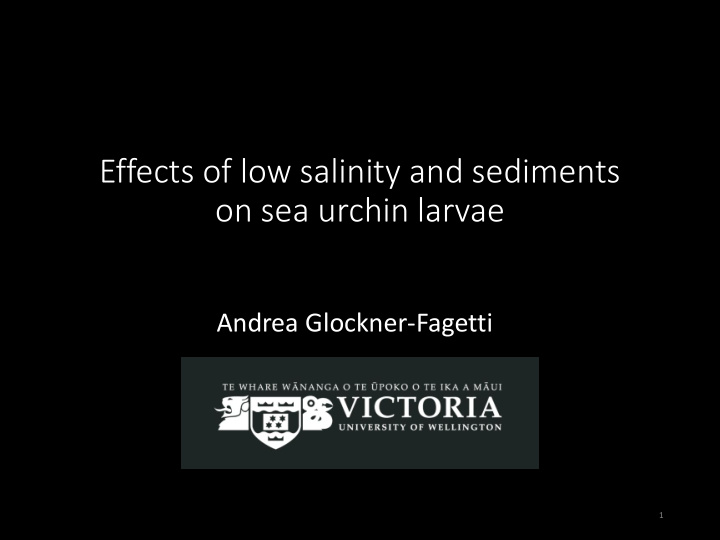



Effects of low salinity and sediments on sea urchin larvae Andrea Glockner-Fagetti 1
What we do at Victoria University Coastal Ecology Lab VUCEL supports SBS research programmes in coastal ecology that are conducted in the Wellington region 2
Annual Open Day @VUCEL 3
We study… • The natural history and biology of organisms • Interactions between organisms • How organisms are affected by their environment 4
Current students 5
PhD in progress… • Ecology and reproduction of sea urchin ( Evechinus chloroticus ) • Species of ecological and economical importance 6
Harbour Study site Wellington Harbour Wellington City South Coast South coast Circulation patterns Exposed to runoff 7
Harbour Research questions Are the differences in density due to different reproductive patterns? If so… what is affecting reproductive patterns? South Coast Do natural stressors affect larval development? How? 8
Life cycle of sea urchins Water column Larval Fertilisation development Spawning Metamorphosis Settlement Recruitment 9 Benthos
Aims 1. To analyze the effects of low salinity and suspended sediments on larval development of kina 2. To estimate the carry-over effects on settlement success 10
Methods: Aim 1 Larval cultures Larval Spawning Fertilisation cultures 11
Methods: Aim 1 Spawning 12
Methods: Aim 1 Fertilisation 15 min later… 24 h later… 13
Methods: Aim 1 Larval cultures 3 days later… 14
Methods: Aim 1 Larval treatments Fully factorial Low salinities design 3x3 28 32 36 Replicates x3 Measurements: Low Low Suspended Arm length sediments Survival High Proportion of High normal larvae No Statistical (Control) analysis: Multi-factorial No ANOVA 15
Methods: Aim 2 Carry-over effects on settlement Settlement success 16
Results 17
PO Results: Aim 1 Larval growth Sediment effect Salinity effect Salinity 28 Salinity 32 Salinity 36 (Control) 0.6 0.5 PO arm length (mm) 0.4 0.3 0.2 0.1 0.0 3 7 14 21 Day Growth delayed by salinity 28 18
PO Results: Aim 1 Larval growth Sediment effect Salinity effect Low High No (Control) 0.6 0.5 PO arm length (mm) 0.4 0.3 0.2 0.1 0.0 3 7 14 21 Day 19
Normal Results: Aim 1 Proportion of normal larvae at different salinity treatments Abnormal 28 32 36 1 Proportion of normal larvae 100 µm 0.8 0.6 0.4 0.2 0 Day 3 Day 7 Day 14 Day 21 20
Aim 2 Results: Aim 2 Settlement success 28 32 36 Settlement success (%) 40 Results 30 20 10 0 Low High Control Sediment treatment Larvae exposed to salinity 28 had lowest settlement success 21
Results: Aim 2 Survival of settlers Normal 28 32 36 25 Number of settlers 20 Abnormal 15 10 5 0 1 2 3 4 Week 22
Summary • Low salinities had a negative effect on larval growth and caused strong abnormalities • Combination of low salinity and high sediments caused lowest larval survival rates • Settlement success was less than 10% for larvae exposed to salinity 28 • Carry-over effects on survival and growth of settlers 23 23
Conclusion Even a short exposure to stressors during larval development has strong consequences in settlement, which could compromise recruitment to the adult population Further studies are needed to investigate long-term survival of settlers 24
Thank you for your attention! …any questions? 25
Recommend
More recommend